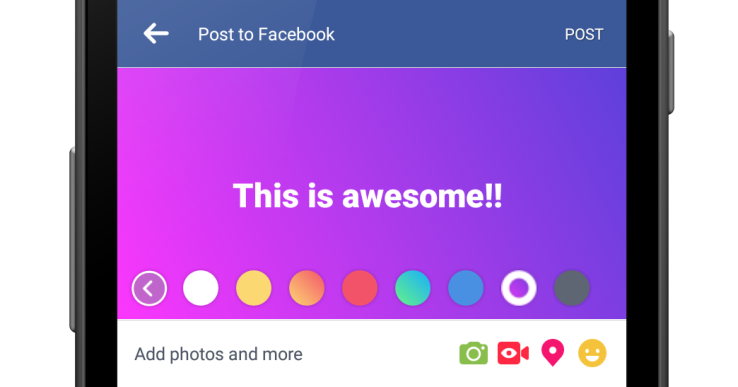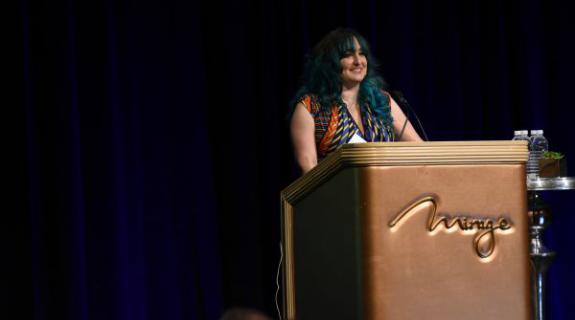Social media expert Bex Schwartz, executive creative director of Alkemy X, walked attendees through what sort of content works best on all of the most popular social media platforms at Station Summit 2017 in Las Vegas on Thursday.
“Marketers need to figure out who their audience is and where they are watching. It’s important to understand where people are watching,” she said. “Once you know that, you can create content strategically targeted for the platform on which it will live.”
Schwartz gave the audience of TV station marketers quick primers on each of the top social media platforms, starting with Facebook.
Facebook autoplays videos, which has ushered in the era of the soundless video. “If you need audio, bake in captions,” Schwartz advised.
Keep videos super short, in keeping with audiences’ super-short attention spans.
“Videos between 30- and 45-seconds are okay. Under 30 is better. Less than 15 is amazing,” she said.
But sometimes, a long video will work if the content warrants it. Below is a video of anchors at WGN Chicago killing time during commercial breaks that was captured by their crew and put up on YouTube. It’s received more than 7 million views.
“Everything is content,” Schwartz said. “There’s no such thing as cutting room floor. Put your stills, bloopers, behind-the-scenes mess ups on social media.”
Something that Facebook has recently offered is the option for people to create their status updates in block letters over a colorful gradient.

“I don’t know why doing this boosts engagement, but it does, and you can use that to your advantage,” Schwartz said.
Insta
First of all, the cool kids call it Insta, never Instagram. You have been warned.
Shorter is better on Insta, says Schwartz. “Insta allows longer videos but don’t go longer than 30 seconds.”
Schwartz also advises posting eye-catching stills or image macros, also known as memes, on this platform.
Twitter is all about GIFs (pronounced with a hard “g” as in graphic image format, swears Schwartz), memes and short clips less than 30 seconds.
“Twitter is where you can amplify your own unique and special snowflake voice,” says Schwartz.
It’s also where talent can amplify their voices, hosting Twitter chats or Q&A sessions.
Tumblr
Younger users and people with intense fandoms tend to be on Tumblr, Schwartz said.
“Tumblr is where fans will take your content and remix it and sprinkle their arts and crafts all over it. Let them.”
In fact, they may take a promo or something else that you have made and call it #mine. This might feel annoying, but it’s part of the user-created social experience.
Snapchat
Snap is perhaps the most mysterious of the social platforms to anyone who isn’t a teenager.
“Snap is designed to be silly, ridiculous and fun,” said Schwartz. “It offers things like super-grabby thumbnails, filters and lenses.”
Snap is ephemeral, with content that’s “designed to disappear into the either,” she says. “Snapchat is a way to make boring content more exciting.”
While Snapchat may be fun to experiment with, you might find that your audiences aren’t really on the platform. If time and/or resources are short, spend your effort on the platform where your audience spends most of its time. For TV stations, this tends to be Facebook.
Giphy
Giphy, which many people probably haven’t even heard of, is less a platform and more a tool. It’s a place where you can turn memes into GIFs. For TV stations, this might be a good place to seed GIFs featuring your talent in the hopes that they get picked up.
For example, you can make a GIF of one of your anchors or weather personalities and then tag it accordingly:
You can also see what your audience is “giffing” and “use that knowledge like you’re in the CIA,” says Schwartz.
There also are, of course, some don’ts when it comes to social media.
Some of them are obvious, such as, don’t inappropriately appropriate culture; don’t post things that are racist, bigoted, homophobic and the like; and don’t turn to played-out memes.
Mistakes happen though, so don’t be scared to experiment.
“Social media is a really great way for people to call out your mistakes and make a lot of fun of you,” Schwartz says.
In the end though, well-executed social media campaigns can move the needle for your TV station.
Says Schwartz: “Does social drive ratings? My answer is yes.”
Tags:













































__twocolumncontent.jpg)











